10 Types of Sushi, Explained
You love sushi, but you typically don’t stray too far from your standard order because...well, you can’t make heads or tails of the menu at your local sushi restaurant. For starters, "sushi" comes from a Japanese word that means "sour rice." In Japan, it's very simple and doesn't contain too many fancy ingredients beyond the fish, but Western-style sushi can have a myriad of toppings. Fear not: PureWow writer Emma Singer spoke to sushi experts Brian Chau and Eric Jue of Chau Time for the full scoop on ten different types of sushi, so you can order with confidence next time. Sushi for beginners starts now.
How to Make Your Own Sushi at Home
Meet the Experts
1. Sashimi
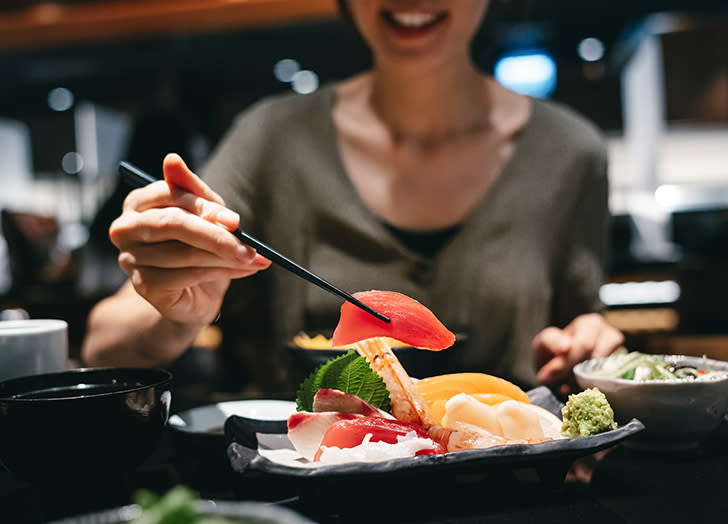
d3sign/getty images
Types of Sashimi
Salmon (sake)
Tuna (maguro)
Yellowtail (hamachi)
Sashimi refers to raw seafood cut into thin slices. It’s a simple dish that Chau says is deceptively hard to prepare, as the seafood must be cut perfectly to “ensure the mouthfeel is smooth and the bite has a melt-in-your mouth quality.” Any mistake in the cut will be noticeable to the consumer. Given the skill required to properly prepare sashimi, it should come as no surprise that this is a popular type among sushi connoisseurs. In fact, Jue describes sashimi as “the purist way of consuming seafood,” adding that it’s also appealing to those who are looking for a low-carb alternative to rice-filled rolls.
As for the best way to enjoy such high-end sushi, Jue and Chau recommend eating it in one bite without soy sauce, so as to not overpower the subtle flavor and texture of the seafood. “As you chew, let the flavor of the seafood coat the tongue and mouth,” says Chau. “Try to pick up some sweetness characteristic of seafood dishes. Try to feel the texture.”
2. Nigiri (Nigirizushi)
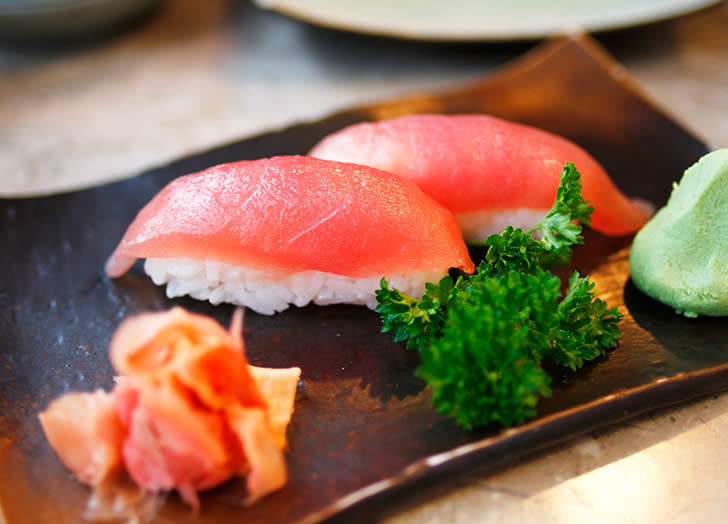
A longer speech/getty images
Types of Nigiri
Sea bass (tai)
Squid (ika)
Tuna belly (toro)
Nigiri consists of a hand-pressed bed of rice that is typically topped with a single piece of seafood and sometimes an accoutrement, like a glaze or a little bit of fish roe, which is added to “complement the flavors and add depth of flavor from the sushi chef’s perspective” says Chau. Although the (almost always raw) seafood is the star of the show here, the vinegary sushi rice plays an important role as well, namely by adding “complexity and texture to the overall experience.” As such, try not to drench your nigiri in soy sauce—a quick dip will do—and aim to enjoy the combination of flavors and texture in one bite, not two. Per Jue, chutoro (medium fatty tuna), otoro (fatty tuna), unagi (eel) and egg (tamago) are a few notable favorites for nigiri newcomers to try.
3. Maki (Makizushi)
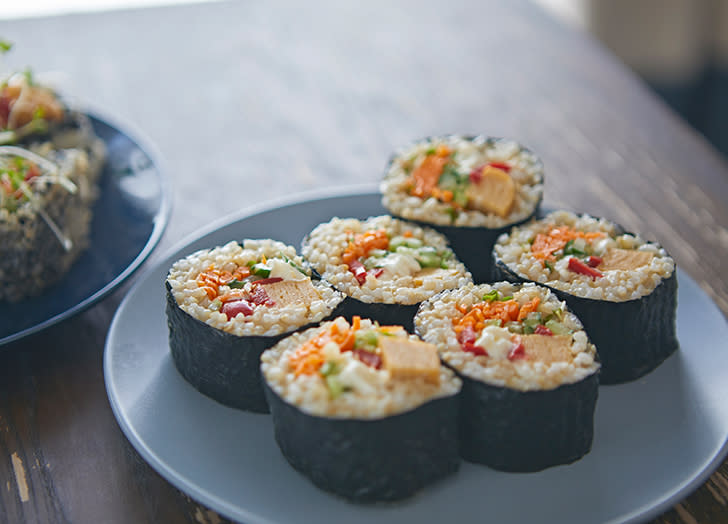
Yuki Kondo/getty images
Types of Maki
Hosomaki (thin roll)
Chumaki (medium roll)
Futomaki (thick roll)
Let’s enter more familiar territory. When you think about sushi, it’s most likely a maki roll that comes to mind. This type of sushi boasts a sheet of nori (i.e., seaweed) on the outside, which is wrapped around sushi rice to help contain both the rice and the sushi filling at the center. You won’t be wanting for variety if you stick with maki rolls, as fillings include everything from raw and cooked seafood to vegetarian and vegan sushi options. These rolls can be simple (i.e., minimal ingredients) or more complex—like if they’re topped with fried shrimp or sauces for added visual appeal. Chau suggests eating maki as is or dipping the pieces in soy sauce if no other sauce or glaze is present. He also points out that maki rolls, which are cut into six or eight pieces, are excellent for sharing. (Hint: This allows you to sample more than one type of roll.)
4. Uramaki
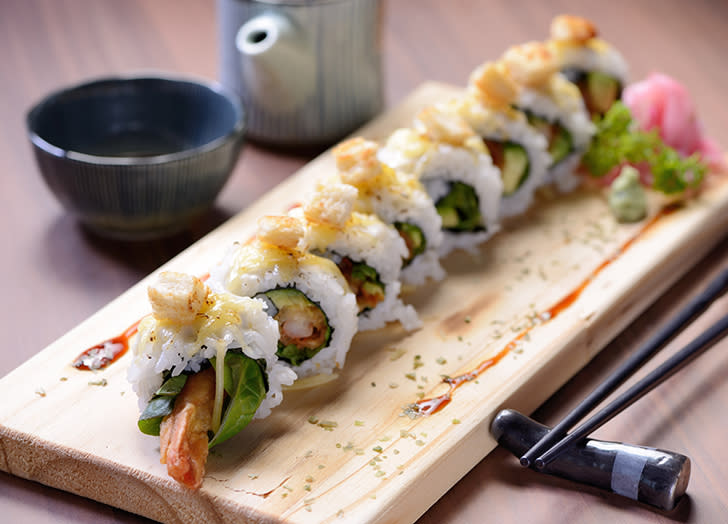
Jordan Lye/getty images
Types of Uramaki
California roll
Rainbow roll
Philadelphia roll
Uramaki and maki have a lot in common, but the key difference between the two is in the composition. Uramaki is an inside-out roll with rice on the outside, followed by a sheet of nori and sushi filling at the center. Beyond that, there’s not too much that sets uramaki apart from maki—both types of sushi are available with a wide variety of fillings, ranging from cooked and raw seafood to veggies, and sometimes come with extra bells and whistles on top. Bottom line: Both maki and uramaki share the title of most popular type of sushi stateside, which is likely because their preparation provides consumers (including those who feel squeamish about eating raw fish) with plenty of options.
5. Temaki (Temakizushi)
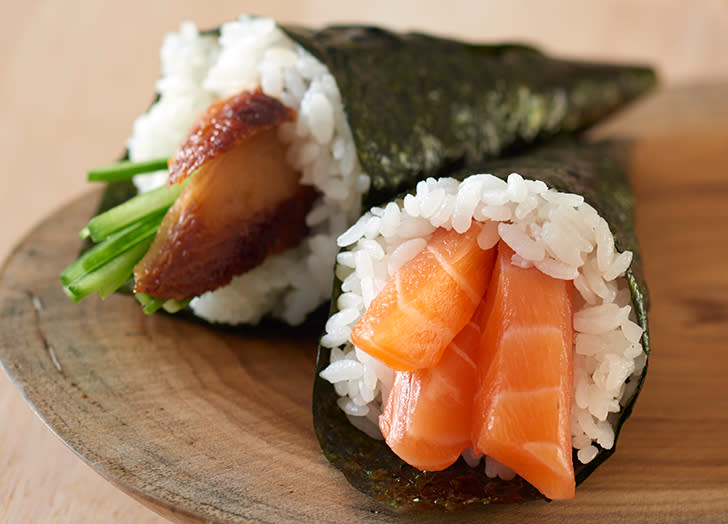
Son Gallery - Wilson Lee/getty images
Types of Temaki
Amberjack (kanpachi)
Scallop (hotate)
Sweet shrimp (amaebi)
Put down your chopsticks and grab a stack of napkins, because temaki is a particularly fun type of sushi that’s meant to be eaten with your hands—and yes, it will be messy. Chau tells us that these stuffed seaweed cones are very customizable and also a particularly creative type of sushi, both in terms of the (many) ingredients you can find inside, as well as how they are served. In general, you can expect a tidy, cone-shaped package, either served on a plate or inserted into a cup that contains a combination of veggies, seafood and sauces. The end result is a type of sushi that boasts an impressive range of flavors and textures and is intended to be enjoyed personally (i.e., not shared) at large gatherings.
6. Gunkan
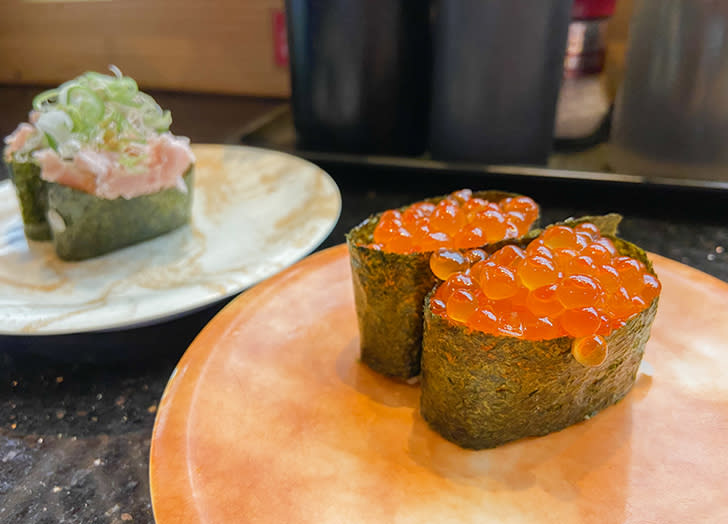
Chikako Nobuhara/getty images
Types of Gunkan
Salmon roe
Sea urchin (uni)
Spicy tuna
Gunkan means ‘war boat’ in Japanese, and that’s exactly what this type of sushi resembles. As for how this aesthetic is achieved, Jue tells us that gunkan, which is a type of nigiri, consists of “sushi wrapped around a small bed of rice and topping…[with] seaweed forming a barrier to contain the desired topping and rice forming the base upon which the topping rests.” The unique composition of this style of sushi makes it ideal for holding together chopped or loose pieces of seafood, with salmon roe, uni and spicy tuna being among the most common toppings. Gunkan can be consumed as is or with soy sauce. For the latter, Jue recommends either gently dipping one corner of the piece directly into the soy sauce, or dipping a piece of ginger into the soy sauce and lightly dabbing the topping of the gunkan.
7. Chirashi (Chirashizushi)
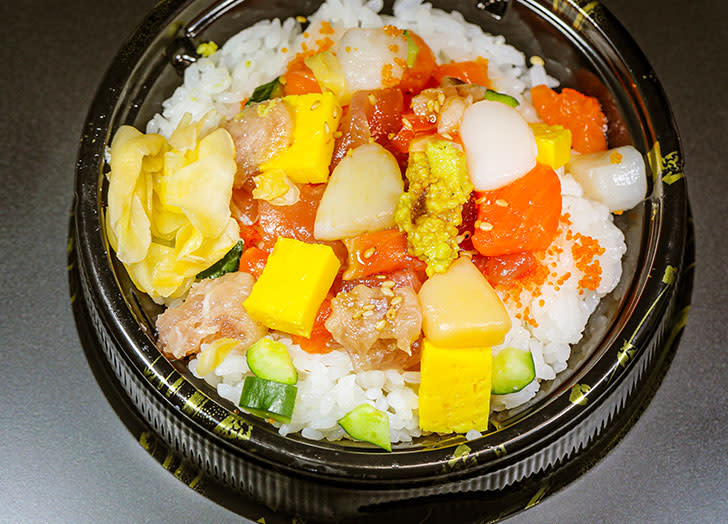
DigiPub/Getty Images
Types of Chirashi
Gomoku (made with cooked ingredients, ornate)
Edomae (made with raw seafood)
Most Americans are more familiar with sushi rolls—tidy little packages of raw fish or veggies and rice—but chirashizushi is a different style of sushi that features the same key ingredients, but in a deconstructed presentation. In fact, chirashizushi, which translates to “scattered sushi,” is essentially a bowl of vinegary sushi rice and raw fish served with assorted garnishes, such as nori, salmon roe and shredded egg. This type of sushi is commonly served at parties or large gatherings, since it’s easy to share, and the preparation isn’t quite as painstaking.
8. Temari (Temarizushi)
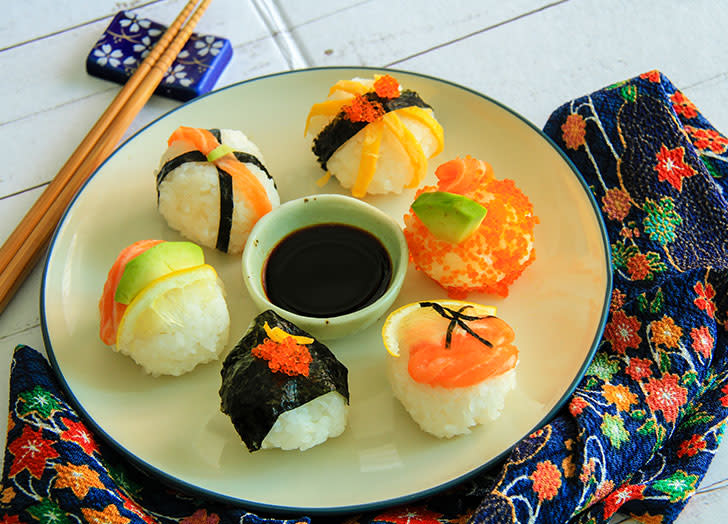
automidori/Getty Images
Types of Temari
Salmon
Tuna
Roe
Here, another type of sushi that’s lesser known stateside, but quite popular in Japan. Temari means “handball” in English—an accurate description of these small, round balls of rice and raw fish. Much like nigiri, temari consists of a hand-pressed bed of sushi rice and various toppings; the only difference between the two styles is that temari has a daintier and tidier spherical shape. Believe it or not, you don’t need much practice to pull off this eye-pleasing presentation. That said, selecting toppings that bring a variety of textures and flavors to the finished dish does require creativity and skill.
9. Inari (Inarizushi)
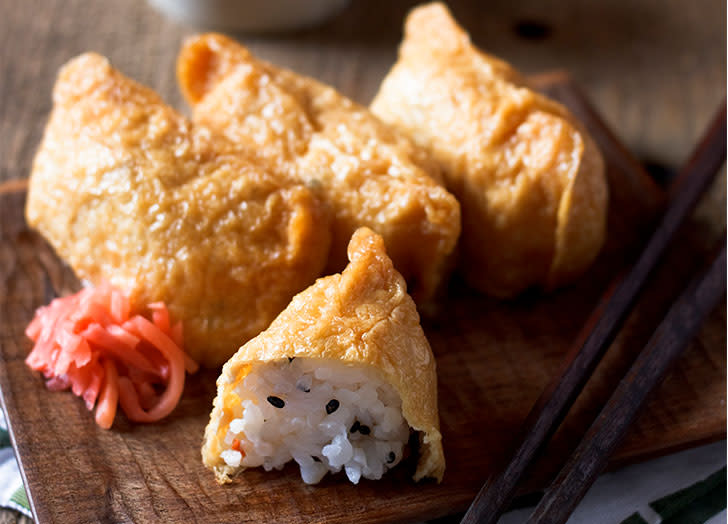
masahiro Makino/Getty Images
Types of Inari
Egg (tamago)
Seaweed salad
Noodles
This type of sushi is very different from your average maki roll, friends. Inari, or “fox sushi” in English, is a popular picnic food in which seasoned sushi rice is enclosed in a pocket of deep-fried tofu (i.e., abura-age) that has been simmered in a sweet broth of dashi, soy sauce and mirin. Though not technically a dessert dish, inari is only slightly savory and can certainly satisfy a sweet tooth.
10. Hako (Hakozushi)
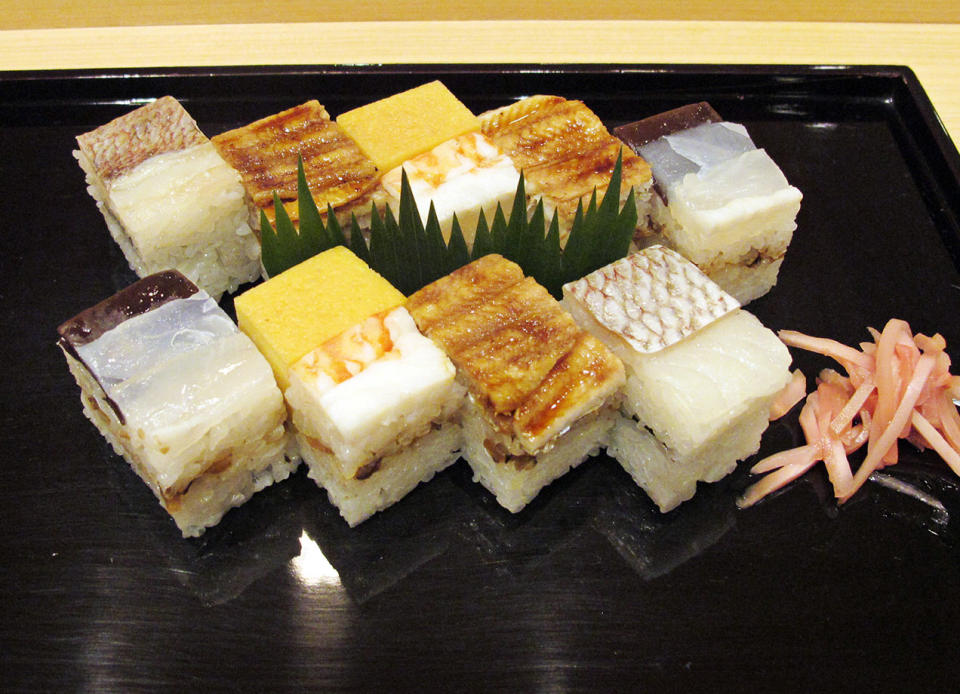
South China Morning Post/Contributor/Getty Images
Types of Hako
Spicy tuna
Eel (unagi)
Salmon (sake)
This eye-catching type of sushi is prepared by filling a square or rectangular box with sushi rice, topping it with more ingredients, pressing it all down from the top and slicing it into pieces. Pressed sushi, called oshi sushi, is a style native to the Osaka region of Japan.
Types of Fish in Sushi
There are tons of seafood ingredients that are fair game for sushi. But in the U.S., popular options include:
Yellowtail (hamachi/kanpachi)
Crab (kani)
Eel (fresh/unagi or saltwater/anago)
Salmon (sake)
Scallop (hotate)
Octopus (tako)
Snapper (tai)
Shrimp (ebi)
Tuna (yellowfin, bigeye, bluefin)
How Long Does Sushi Last in the Fridge? What to Know About Leftovers

